Honor Award
Dust to Dust
Laura Bryant, Student ASLA and Chelsea Vargas, Student ASLA, Graduate, University of Texas at Austin
Faculty Advisor: Jason Sowell
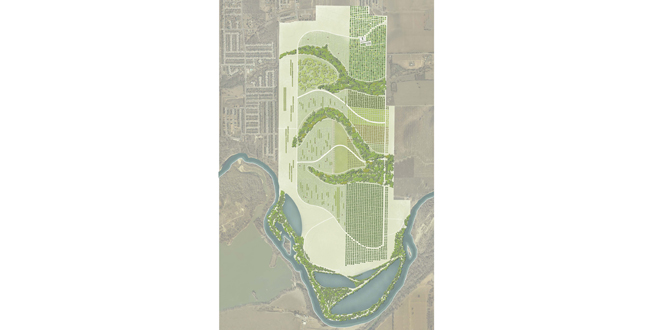
 Close Me!
Close Me!Geology framework— Individual markers are based on the geological patterns of sedimentation. The marker is inserted within the wall, appearing as a layer embedded within the larger stratification. The larger plot is established by the geometry of fault. Line, and ultimately, the site elements are organized in the manner of fluvial deposition.
Download Hi-Res ImageImage: Laura Bryant and Chelsea Vargas
Image 2 of 12
 Close Me!
Close Me!Context maps — The site is situated in Austin, Texas along the Colorado River and the Balcones Faults. It is located 30 minutes from downtown Austin, accessible from Hwy 183 and SH-130. The site is bordered by suburban development on the northwest edge, with an existing pecan orchard along the southeastern edge and two riparian swales.
Download Hi-Res ImageImage: Laura Bryant and Chelsea Vargas
Image 3 of 12
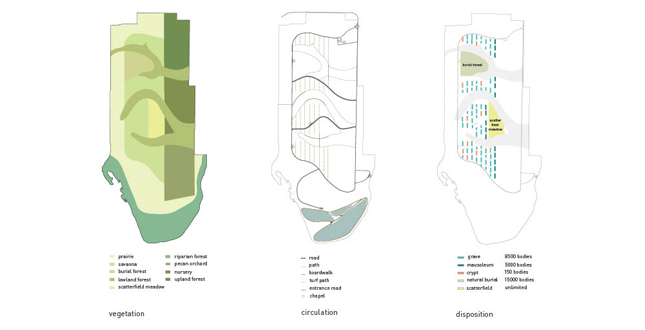 Close Me!
Close Me!Site diagrams — The site’s vegetation plan is based on existing patterns, including the pecan orchard and the two swales that run throughout the site. These decisions set up larger circulation networks, consisting of a ring road that encircles disposition. Graves, mausoleums and crypts are then arranged in linear rows within this larger boundary.
Download Hi-Res ImageImage: Laura Bryant and Chelsea Vargas
Image 4 of 12
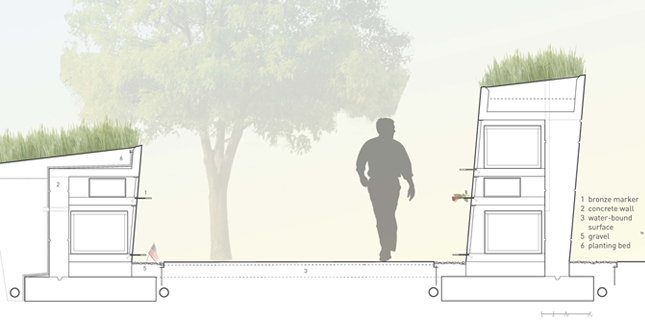 Close Me!
Close Me!Mausoleum — The mausoleum consists of a wide avenue flanked by two walls on either side for bodily interment and chambers for cremains. Like the markers used within the grave and crypt, they serve as shelves for visitors to leave mementoes and flowers.
Download Hi-Res ImageImage: Laura Bryant and Chelsea Vargas
Image 5 of 12
 Close Me!
Close Me!Crypt — The crypt serves as the most private of disposition types, offering a quiet, cool place where sunlight filters through, reflecting on individual markers. Blossoms of the Texas mountain Laurel fall in and scatter on the ground, while a limestone bench offers a shaded resting place for contemplation.
Download Hi-Res ImageImage: Laura Bryant and Chelsea Vargas
Image 6 of 12
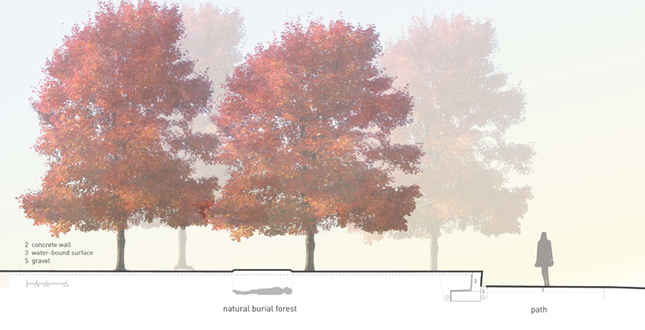 Close Me!
Close Me!Natural burial — The natural burial forest is an elevated platform of big tooth maple trees, situated within the boundaries of the site’s northernmost swale. A retaining wall acts as a bench as well as a threshold to protect this disposition zone. Like the scatter field, names are not indicated, but represented through the plantings of individual trees.
Download Hi-Res ImageImage: Laura Bryant and Chelsea Vargas
Image 7 of 12
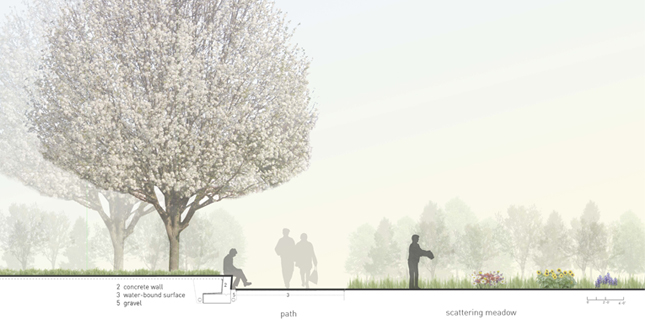 Close Me!
Close Me!Scatter field — The scatter field is an open meadow where one can scatter a loved one’s ashes along with a handful of wildflower seeds. Demarcated by a retaining wall that also serves as a bench, the scatter field does not indicate the names of the buried, but simply allows for the growing plants to serve as an ephemeral trace of the past.
Download Hi-Res ImageImage: Laura Bryant and Chelsea Vargas
Image 8 of 12
 Close Me!
Close Me!Grave — The grave marker is a ¾" bronze plate that is inserted within a concrete retaining wall, which supports a gradually sloping landform. The marker's placement allows for one to look down and reflect, while also serving as a shelf for mementoes. At the edge of the slope, one can plant and maintain a flower bed in honor of a loved one.
Download Hi-Res ImageImage: Laura Bryant and Chelsea Vargas
Image 9 of 12
 Close Me!
Close Me!Funeral at grave site — The landform's gradual slope provides a distinctive zone for a ceremony to take place, gently elevating the position of the preacher and providing a backdrop of lush prairie grass. For ease of transporting the body to the site, a hearse is able to drive along the geogrid turf path and park near the site of disposition.
Download Hi-Res ImageImage: Laura Bryant and Chelsea Vargas
Image 10 of 12
 Close Me!
Close Me!Visitation at grave site — Visitors are encouraged to participate in rituals of personalization when visiting the site. The marker indicating the name of the individual also serves as a shelf on which mementoes can be placed. Flowers or flags can be inserted within the gravel beneath the market. In an effort to individualize specific markers, a planting bed above the body allows for one to participate in planting flowers for a loved one, while also serving as a way to maintain and care for one after death.
Download Hi-Res ImageImage: Laura Bryant and Chelsea Vargas
Image 11 of 12
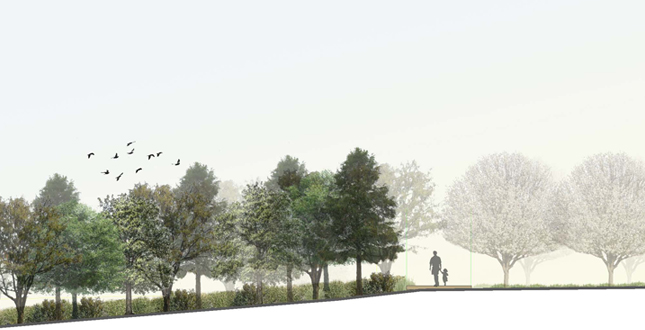 Close Me!
Close Me!Boardwalk along swale — The swales that run through the site serve as one of the predominant organizing methods of the design. A path winds along the edge of each of these swales, occasionally turning into a boardwalk to allow the vegetation to extend out into the prairie and encourage greater visitor engagement.
Download Hi-Res ImageImage: Laura Bryant and Chelsea Vargas
Image 12 of 12
Project Statement
This proposal for a 990-acre cemetery just east of Austin, Texas draws parallels between the human cycle of life and death and the geological cycle of sedimentation and erosion. The site is shaped by fluvial processes, resulting in two major swales which organize the zones of disposition, each formed as a cut in the earth. The detailing of the burial plots themselves highlight the act of sedimentation and the continual change that occurs over time.
Project Narrative
—2011 Student Awards Jury
A cemetery is a place where the connection between body and ground can be directly experienced. The very concept of ashes to ashes, and dust to dust applies not only to the body, but to the earth itself: the geological cycle is defined by the constant creation and destruction of stone, through sedimentation and erosion. This cemetery highlights the act of bodily disposition as an act of cultural sedimentation. In order to create grounds for the dead, we used ideas of geological processes to form the ground in response to disposition. We employed three different types of geological processes for three different scales of the project. The markers are reminiscent of sedimentation, the laying down and cementation of soil over time. The plots are reminiscent of faulting or uplifting, a sudden shift in the earth at a specific moment in time. And the organization of the site is reminiscent of fluvial processes, the cyclical depositing, eroding and shifting of riverbeds over time.
The 990-acre site for the cemetery is located east of Austin, Texas, about 30 minutes from downtown. Sitting along the Colorado river and just east of the Balcones fault zone, the site is bordered to the west and north by single-family housing and to the east by agricultural land. The southern end will be converted to a gravel quarry before the whole site becomes a cemetery.
Currently, the flat and expansive site is used for hay fields and pecan orchards. Two major vegetated swales cut through the site. This existing vegetation is the basis for the three main vegetation types in the proposal. Native prairie will replace many of the hay fields. Bottomland forest will follow the swales and riparian edge. Upland forest, including the existing pecan orchard and a proposed tree nursery, will occupy a band along the eastern edge of the site. The prairies consist primarily of native Texas blackland prairie grasses such as bluestems and muhlys while the turf pathways between disposition plots are planted with a native grass turf mix (including grasses such as buffalo and blue grama). The bottomland forests are planted with species such as bald cypress, cedar elm, and yaupon holly and the upland forest—the eastern strip of orchard, nursery, and forest—includes oaks, pecans, and cedar elms. The trees from the eastern strip are repeated within the area of disposition to provide shade and break up the extensive disposition zones. Although the swales are bounded by pedestrian paths, the paths occasionally become boardwalks allowing for the vegetation of the swale to extend into the prairie areas. Visitors will thus experience both the edge and the interior of the swale.
The proposed program at the site will include both constructed wetlands for recreation and habitat in the southern end of the site (where quarrying will have occurred) and a tree nursery in addition to the primary cemetery program. The cemetery itself will include one primary chapel and crematorium, three smaller chapels, and a reception platform. The cemetery will accommodate six distinct disposition types: in-ground burial, interment in a crypt, interment in a mausoleum, inurnment in a mausoleum, natural burial (in which a shrouded body is placed into a grave dug by family and friends), and ash scattering. These plots will be laid across the slightly undulating terrain.
For each of the disposition types, a concrete retaining wall will appear as a cut in the earth, making layers of sedimentation visible. The concrete will be poured with varying aggregates, cement types, and hydration in order to achieve a stratified appearance and to emphasize the idea of sedimentation. The markers themselves will be highly customizable bronze plates of varying size depending on the type of disposition. The marker plate slides into a poured-in-place-bracket in the wall and serves as a shelf for leaving mementos for the deceased. For those disposition types without individual plots—ash scattering and natural burial—no individual bronze markers are placed. Instead, the wall serves as a threshold to delineate the zones of disposition: a bigtooth maple forest for natural burial and a wildflower meadow for ash scattering. In the scatterfield, wildflower seeds can be scattered along with the ashes, thereby creating a loose, ephemeral marker in the area of scattering.
This proposal aims to give expression to the idea that both the cycle of life and death and the cycle of geological processes allow us to see the passage of time. The vegetation will change and escape the parameters we’ve defined, the ground will continue to shift and change, and the bodies of the deceased will return to the earth and define a new stratum in the physical or geological accumulation of time.
Additional Project Credits
University of Texas at Austin
Hope Hasbrouck, Assistant Professor; Carmen Garufo, Assistant Professor; Matt Fajkus, Assistant Professor
Eddy Wylie Designs
Eddy Wylie, Principal






